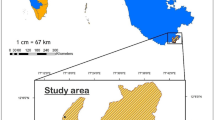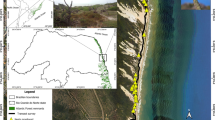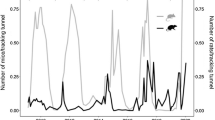Abstract
The nests of the harvest mouse (Micromys minutus) from an extensively used farmland in Western Poland were recognized as a place of occurrence of a large group of invertebrates. In total, from 42 nests 6,544 individuals of invertebrates were extracted. The number of invertebrates was positively correlated with mass of mouse nests. There were found arthropods belonging to the following groups: Arachnida: spiders, mites and pseudoscorpions; Entognatha: springtails; Insecta: Coleoptera, Diptera, Hemiptera, Hymenoptera, Lepidoptera, Psocoptera, Siphonaptera and Thysanoptera. The most numerous groups were mites (Acari, 5,800 individuals) and fleas (Siphonaptera, 415 individuals). Among mites Astigmatida, Mesostigmata and Oribatida were identified. One species, Tyrophagus curvipenis (Acari: Astigmatina), was found in Poland for the first time. The study clearly showed that nests of the harvest mouse are often inhabited by invertebrates, and looks like some of them are characteristic to this particular kind of habitat.
Similar content being viewed by others
References
Alvarez T., Frampton G.K. & Goulson D. 1997. Population dynamics of epigeic Collembola in arable fields: the importance of hedgerow proximity and crop type. Pedobiologia 41: 110–114.
Bajerlein D., Bloszyk J., Gwiazdowicz D., Ptaszyk J. & Halliday B. 2006. Community structure and dispersal of mites (Acari, Mesostigmata) in nests of the white stork (Ciconio, ciconia). Biologia 61: 525–530. DOI: https://doi.org/10.2478/sll756-006-0086-9
Bence S.L., Stander K. & Griffiths M. 1999. Nest site selection by the harvest mouse (Micromys minutus) on arable farmland. Asp. Appl. Biol. 54: 197–202.
Bence S.L., Stander K. & Griffiths M. 2003. Habitat characteristics of harvest mouse nests on arable farmland. Agr. Ecosyst. Environ. 99: 179–186. DOI: https://doi.org/10.1016/S0167-8809(03)00137-3
Bernini F. 1986. Current ideas on the phylogeny and the adaptative radiation of the Acarida. Boll. Zool. 53: 279–314 DOI: https://doi.org/10.1080/11250008609355512
Bias M.A. & Morrison M.L. 2006. Habitat selection of the salt marsh harvest mouse and sympatric of the rodent species. J. Wildl. Manage. 70: 732–742. DOI: https://doi.org/10.2193/0022-541X(2006)70[732:HSOTSM]2.0.CO;2
Bloszyk J., Bajerlein D., Gwiazdowicz D.J., Halliday R.B. & Dylewska M. 2006. Uropodine mite communities (Acari: Mesostigmata) in birds’ nests in Poland. Belg. J. Zool. 136: 145–153.
Bregetova N.G. 1956. Gamazovye kleshchi (Gamasoidea). Kratkii opredelitef. Opredeliteli po faune SSSR, izdavaemye Zoo-logicheskim institutom AN SSSR Vypusk 61 [Gamasid mites (Gamasoidea). The short keys] Izdatelstvo Akademii Nauk SSSR, Moskva, Leningrad, 247 pp.
Bulanova-Zachvatkina E.M., Usova Z.B., Skliar B.E. & Jarosenko N.N. 1974. Pancirnye kleshchi (Oribatei) iz gnezd melkikh mlekopitayushchikh Doneckogo Priazoviya [Oribatid mites (Oribatei) from nests of small mammals in Doneck Region]. Vest. Zool. 1: 17–21.
Burakowski B., Mroczkowski M. & Stefańska J. 1986. Chrząszcze — Coleoptera. Cucujoidea, częšč 2. Catalogus Faunae Poloniae 23 (13): 1–278.
Butcher J.W., Snider R. & Snider J. 1971. Bioecology of edaphic Collembola and Acarina. Annu. Rev. Entomol. 16: 249–287. DOI: https://doi.org/10.1146/annurev.en.16.010171.001341
Büchner S., Stubbe M. & Striese D. 2003. Breeding and biological data for the common dormouse (Muscardinus avellanarius) in Eastern Saxony (Germany). Acta Zool. Acad. Sci. Hung. 49 (Suppl. 1): 19–26.
Chmielewski W. 1977. Data concerning the occurrence of some species of allergenic mites (Acaroidea) in Poland. Wiad. Parazytol. 23: 109–113.
Christiansen K. 1964. Bionomics of Collembola. Annu. Rev. Entomol. 9: 147–178. DOI: https://doi.org/10.1146/annurev.en.09.010164.001051
Christiansen K. 1970. Experimental studies on aggregational dispersion of Collembola. Pedobiologia 10: 180–189.
Cianciolo J.M. & Norton R.A. 2006. The ecological distribution of reproductive mode in oribatid mites, as related to biological complexity. Exp. Appl. Acarol. 40: 1–25. DOI: https://doi.org/10.1007/sl0493-006-9016-3
Coleman D.C. 1985. Through a ped darkly: An ecological assessment of root-soil-microbial-faunal interactions, pp. 1–21. In: Fitter A.H., Atkinson D., Read D.J. & Usher M.B. (eds), Ecological Interactions in Soil: Plant, Microbes and Animals, Special Publication No. 4 of the British Ecological Society, Blackwell, Oxford, 460 pp. ISBN-13: 978-0632013869, ISBN-10: 0632013869
Cyprich D., Krumpál M. & Lukáš J. 1992. Contribution to the knowledge of the flea fauna (Siphonaptera) of dormouse nests (Myoxidae) in Slovakia. Parasit. Hung. 25: 97–105.
De Jonge G. & Dienske H. 1978. Habitat and interspecific displacement of small mammals in the Netherlands. Neth. J. Zool. 29: 177–214. DOI: https://doi.org/10.1163/002829679X00278
Dickman C.R. 1986. Habitat utilization and diet of the harvest mouse, Micromys minutus, in an urban environment. Acta Theriol. 31: 249–256. DOI: https://doi.org/10.4098/AT.arch.86-24
Evans G.O. & Till W.M. 1966. Studies on the British Dermanyssidae (Acari: Mesostigmata). Part II Classification. Bull. Br. Mus. (Nat. Hist.) Zool. 14: 109–370.
Fain A. & Fauvel G. 1993. Tyrophagus curvipenis n. sp. from an orchid cultivation in a greenhouse in Portugal (Acari: Acaridae). Int. J. Acarol. 19: 95–100. DOI: https://doi.org/10.1080/01647959308683544
Fan Q.H. & Zhang Z.Q. 2007. Tyrophagus (Acari: Astigmata: Acaridae). Fauna of New Zealand 56. Manaaki Whenua Press, Lincoln, New Zealand, 291 pp. ISBN: 978-0-478-09386-5
Fedor P.J., Doričová M., Dubovský M., Prokop P., Sierka W., Kiselák J. & Zvarík M. 2010. Cereal pests among nest parasites — the story of barley thrips, Limothrips denticornis Haliday (Thysanoptera: Thripidae). Entomol. Fenn. 21: 221–231.
Gwiazdowicz D.J., Błoszyk J., Bajerlein D., Halliday R.B. & Mizera T. 2006. Mites (Acari: Mesostigmata) inhabiting nests of the while-tailed sea eagle Haliaeetus albicilla (L.) in Poland. Entomol. Fenn. 17: 366–372.
Gwiazdowicz D.J. & Filip K.P. 2009. Ophionyssus saurarum (Acari, Mesostigmata) infecting Lacerta agilis (Reptilia, Lacertidae). Wiad. Parazytol. 51: 61–62 PMID: 19579788
Harris S. 1979. History, distribution, status and habitat requirements of the harvest mouse (Micromys minutus) in Britain. Mammal Rev. 9: 159–171. DOI: https://doi.org/10.1111/j.1365-2907.1979.tb00253.x
Joosse E.N. & Verhoef H.A. 1974. On the aggregation habits of surface dwelling Collembola. Pedobiologia 14: 245–249.
Juskaitis R. & Remeisis R. 2007. Harvest mice Micromys minutus and common dormice Muscardinus avellanarius live sympatric in woodland habitat. Acta Theriol. 52: 349–354. DOI: https://doi.org/10.1007/BF03194232
Klimov P.B. & O’Connor B.M. 2009. Conservation of the name Tyrophagus putrescentiae, a medically and economically important mite species (Acari: Acaridae). Int. J. Acarol. 35: 95–114. DOI: https://doi.org/10.1080/01647950902902587
Klimov P.B. & O’Connor B.M. 2010. Acarus putrescentiae Schrank, 1781 (currently Tyrophagus putrescentiae; Acariformes, Acaridae): proposed conservation of usage by designation of a replacement neotype. Bull. Zool. Nomenclature 67: 24–27. Case 3501.
Krantz G.W. & Walter D.E. 2009. A Manual of Acarology. Third edition. Texas Tech University Press, Lubbock, USA, 807 pp. ISBN: 978-0-89672-620-8.
Krivolutskij D.A. 1995. (ed.) Pancirnye kleshchi. Oribatid mites: Morfologiya, razvitie, fllogeniya, ekologiya, metody issledovaniya, kharakteristika modeljnogo vida Nothrus palustris CL. Koch, 1839 [Oribatid mites. Morphology, development, phylogeny, ecology, methods of study, model species Nothrus palustris (CL. Koch, 1839)]. AN Institut probl. ekologii i evolyucii im. A.N. Severcova, Ros. Kom. Po progr. JUNESKO “Chelovek i biosfera” Moskva, Nauka. [Moscow, Nauka Publishers], 224 pp.
Kuroe M., Ohori S., Takatsuki S. & Miyashita T 2007. Nest-site selection by the harvest mouse Micromys minutus in seasonally changing environments. Acta Theriol. 52: 355–360. DOI: https://doi.org/10.1007/BF03194233
Kuroe M., Yamaguchi N., Kadoya T. & Miyashita T. 2011. Matrix heterogeneity affects population size of the harvest mice: Bayesian estimation of matrix resistance and model validation. Oikos 120: 271–279. DOI: https://doi.org/10.1111/j.1600-0706.2010.18697.x
Luxton M. 1972. Studies on the oribatid mites of a Danish beech wood soil. I. Nutritional biology. Pedobiologia 12: 434–463.
Mašán P. & Fend’a P. 2010. A review of the laelapid mites associated with terrestrial mammals in Slovakia, with a key to the European species (Acari: Mesostigmata: Dermanyssoidea). Institute of Zoology Slovak Academy of Sciences, NOI Press, Bratislava, 187 pp. ISBN: 978-80-970406-8-0
Mašán P., Fenda P., Krištofík J. & Halliday B. 2014. A review of the ectoparasitic mites (Acari: Dermanyssoidea) associated with birds and their nests in Slovakia, with notes on identification of some species. Zootaxa 3893: 77–100. DOI: https://doi.org/10.11646/zootaxa.3893.1.3.
Mašán P. & Stanko M. 2005. Mesostigmatic mites (Acari) and fleas (Siphonaptera) associated with nests of mound-building mouse, Mus spicilegus Petényi, 1882 (Mammalia, Rodentia). Acta Parasitol. 50: 228–234.
Mebes K.H. & Filser J. 1997. A method for estimating the significance of surface dispersal for population fluctuations of Collembola in arable land. Pedobiologia 41: 115–122.
Micherdziński W. 1980. Eine taxonomische Analyse der Familie Macronyssidae (Oudemans, 1936). I. Subfamilie Ornithonyssinae (Lange, 1958) (Acarina, Mesostigmata). (Praca wykonana w ramach problemu MR) (German Edition) PWN, Warsaw, 264 pp. ISBN-10: 8301015322, ISBN-13: 9788301015329
Mound L.A. & Kibby G. 1998. Thysanoptera an Identification Guide. Wallingford, CAB International, 70 pp. ISBN-10: 0851992110, ISBN-13: 9780851992112
Němec F. 1993. Flea community inhabiting nests of the common vole (Microtus arvalis [Pallas, 1779]) in west Bohemian farmland. Folia Musei Rerum Naturalium Bohemiae Occidentalis, Zoologica 38: 1–37.
Norton R.A., Kethley J.B., Johnston D.E. & O’Connor B.M. 1993. Phylogenetic perspectives on genetic systems and reproductive modes of mites, pp. 8–99. In: Wrensch D. & Ebbert M. (eds), Evolution and Diversity of Sex Ratio in Insects and Mites, Chapman and Hall, USA, 634 pp. ISBN: 978-0-412-02221-0
Olejniczak I. 2000. Effects of simplification of grass cultures and soil conditions on Collembola (Apterygota) communities in a lysimetric experiment. Pol. J. Ecol. 48: 209–224.
Ozkan B., Yigit N. & Colak E. 2003. A Study on Micromys minutus (Pallas, 1771) (Mammalia: Rodentia) in Turkish Thrace. Turk J. Zool. 27: 55–60.
Pelikán J., Fedor P., Krumpál L. & Cyprich D 2002. Strapky (Thysanoptera) v hniezdach vtakov a cicavcov na Slovensku. Thrips (Thysanoptera in nests of birds and mammals in Slovakia. Ekologia (Bratislava) 21: 275–282.
Perrow M. & Jowitt A. 1995. What future for the harvest mouse? British Wildlife 6: 356–365.
Reeves R.M. 1967. Oribatei from a bird nest. Acarologia 9: 284–289. ISSN: 0044-586X
Rosický B. 1957. Fauna ČSR. Svazek 10, Blechy — Aphaniptera. Praha, Nakladatelství ČSAV, 439 pp.
Sandner H. & Wasylik A. 1973. The mites of the sparrow nests and the danger of infestation of grannaries by them. Ekol. Pol. 21: 323–338.
Schatz H. 1983. Catalogus Fauna Austriae, Teil IX i - Ordn.: Oribatei, Hornmilben. Vienna, Osterreichischen, Akademie der Wissenschaften, 118 pp. ISBN-13: 978-3-7001-0613-5, ISBN-10: 3-7001-0613-0
Seastedt T.R. 1984. The role of microarthropods in decomposition and mineralization processes. Annu. Rev. Entomol. 29: 25–46. DOI: https://doi.org/10.1146/annurev.en.29.010184.000325
Sergienko G.D. 1983. Oribatidy gnezd nekotorykh ptits i mleko-pitayushchikh [Oribatids from the nests of some birds and mammals]. Vestn. Zool. 2: 26–31.
Solarz K. 2012. House Dust Mites and storage Mites (Acari: Oribatida: Astigmatina). Identification Keys. Institute of Systematic and Evolution of Animals, Polish Academy of Sciences, Cracow, Poland, 120 pp. ISBN: 978-83-61358-48-0
Solarz K., Szilman P. & Szilman E. 1999. Allergenic mites associated with bird nests in Poland (Astigmata: Pyroglyphidae, Acaridae, Glycyphagidae), pp. 651–656. DOI: https://doi.org/10.1007/978-94-017-1343-656. In: Bruin J., van der Geest L.P.S. & Sabelis M.W. (eds), Ecology and Evolution of the Acari, Series Entomologica, Vol. 55, Springer, Amsterdam, 671 pp. ISBN: 978-90-481-5200-1
Solarz K., Szilman P. & Szilman E. 2004. Occupational exposure to allergenic mites in a Polish Zoo. Ann. Agric. Environ. Med. 11: 27–33. PMID: 15236495
Solarz K., Szilman P., Szilman E., Krzak M. & Jagła A. 2004. Some allergenic species of astigmatid mites (Acari, Astigmata) from different synanthropic environments in southern Poland. Acta Zool. Cracov. 47: 125–145. DOI: https://doi.org/10.3409/173491504783995843
Stanko M., Miklisová D., de Bellocq J.G. & Morand S. 2002. Mammal density and patterns of ectoparasite species richness and abundance. Oecologia 131: 289–295. DOI: https://doi.org/10.1007/s00442-002-0889-5
Subias L.S. 2004. Listado sistemático, sinonímico y biogeográfico de los Ácaros Oribátidos (Acariformes, Oribatida) del mundo (1758–2002). Graellsia 60 (número extraordinario): 3–305. Actualizado en febrero de 2014: https://doi.org/escalera.bio.ucm.es/usuarios/bba/cont/docs/RO 1.pdf (accessed 30.05.2014)
Surmacki A., Goldyn B. & Tryjanowski P. 2005. Location and habitat characteristics of the breeding nests of the harvest mouse (Micromys minutus) in the reed-beds of an intensively used farmland. Mammalia 69: 5–9. DOI: https://doi.org/10.1515/mamm.2005.001
Trout R.C. 1978. A review of studies on populations of wild harvest mice (Micromys minutus (Pallas). Mammal Rev. 8: 143–158. DOI: https://doi.org/10.1111/j.l365-2907.1978.tb00224.x
Tryjanowski P., Baraniak E., Bajaczyk R., Gwiazdowicz D.J., Konwerski S., Olszanowski Z. & Szymkowiak P. 2001. Arthropods in nests of the red-backed shrike (Lanius collurio) in Poland. Belg. J. Zool. 131: 69–74.
Urbani B. & Youlatos D. 2012 Positional behavior and substrate use of Micromys minutus (Rodentia: Muridae): Insights for understanding primate origins. J. Hum. Evol. 64: 130–136. DOI: https://doi.org/10.1016/j.jhevol.2012.10.006
Wasylik A. 1959. Mite fauna (Tyroglyphoidea) in the nests of the common sparrow (Passer domesticus L.). Ekol. Pol. 5: 187–190.
Wasylik A. 1964. Remarks on the dispersion of certain mites. Ekol. Pol. 10: 189–193.
Wasylik A. 1971. Nest types and the abundance of mites. Ekol. Pol. 19: 689–699.
Wasylik A. 1973. The mites (Acaroidea) inhabiting the nests of the tree sparrow (Passer montanus L.). Ekol. Pol. 21: 869–899.
Zar J.H. 1999. Biostatistical analysis. Pearson Education, 4th edn. New Delhi, India, 929 pp. ISBN-10: 8177585827, ISBN-13: 9788177585827
Zhang Z.Q. & Fan Q.H. 2005. Revision of Tyrophagus Oudemans (Acari: Acaridae) of New Zealand and Australia. Landcare Research Contract Report: LC0405/149, New Zealand Ltd, Auckland, New Zealand, 189 pp.
Ždárková E. 1967. Stored food mites in Czechoslovakia. J. Stored. Prod. Res. 3: 155–175. DOI: https://doi.org/10.1016/0022-474X(67)90024-0
Author information
Authors and Affiliations
Corresponding author
Rights and permissions
About this article
Cite this article
Krawczyk, A.J., Augustiničová, G., Gwiazdowicz, D.J. et al. Nests of the harvest mouse (Micromys minutus) as habitat for invertebrates. Biologia 70, 1637–1647 (2015). https://doi.org/10.1515/biolog-2015-0186
Received:
Accepted:
Published:
Issue Date:
DOI: https://doi.org/10.1515/biolog-2015-0186




